An interview with Monica Scarpa, CEO Venice Marco Polo Airport, SAVE Group. By Ross Falconer
Venice is a unique city environmentally, architecturally and historically. Known as “Queen of the Adriatic”, “The Floating City”, or “City of Canals”, Venice and its lagoon environment are a UNESCO World Heritage Site, attracting 25 million tourists annually.
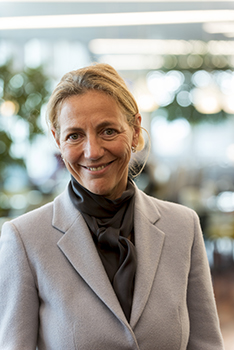
Monica Scarpa, CEO SAVE Group: “When SAVE became a private company, the President decided to create a new team of managers who were not from the airport sector – a sector that until that time was mainly public, with managers with a political rather than a business background. Attracted by this opportunity, which also allowed me to come back to my hometown of Venice after many experiences abroad, I accepted the offer.”
The modern gateway to the city is Venice Marco Polo Airport, which is set in the delicate context of reclaimed land on the edge of the Venetian lagoon. The airport is, rightfully, part of the current narrative of Venice, named for ‘Marco Polo’, the original ‘merchant of Venice’. Its facilities are rich in references to the architecture of the historic centre, combining ancient and modern in a manner designed to be both aesthetic and functional.
Venice Marco Polo is the major airport in the portfolio of SAVE Group, which manages Italy’s ‘North-East Airport System’, including the smaller airports of Treviso, Verona and Brescia. To facilitate increasing passenger numbers (+8% to 11.2 million in 2018), the current focus is on delivering the €900 million Venice Airport Master Plan 2012-2021.
Leading these developments is Monica Scarpa, CEO of SAVE Group. She entered the airports industry as Chief Financial Officer of SAVE Group in 2001, subsequently taking the helm as CEO in 2007. This followed a background in finance at Arthur Andersen, before becoming Chief Financial Officer at The Fashion Box Group, owner of the Replay brand.
“When SAVE became a private company, the President decided to create a whole new team of managers who were not from the airport sector – a sector that until that time was mainly public-owned, with managers with a political rather than a business background,” Scarpa begins. “Attracted by this opportunity, which also allowed me to come back to my hometown of Venice after many experiences abroad, I accepted the offer.”
We meet on International Women’s Day. Scarpa is among several women airport bosses in Italy, including Daniela Baglieri, President of Società Aeroporto Catania, and Gina Giani, CEO of Toscana Aeroporti.
“In the experiences that led me to my current role, I have never had to face gender-based obstacles or impediments of any kind,” says Scarpa. “This does not mean that my professional life is not, in some respect, difficult in relation to a mentality that is still largely male-dominated, but I am lucky to work with
a President and a Board of Directors who believe in meritocracy.”
Managing Venice’s over-heating tourism
Our interview takes place on a crisp, sunny, late-winter’s morning. As we begin our descent into Venice Marco Polo, we can see the azure blue canals and Venetian Gothic architecture that characterise the lagoon city – the airport located just 8km from its cultural and touristic heart.
The airfield is a hub of activity – alongside the typical aviation-related movements, the comprehensive redevelopment of the runways and taxiways is ongoing. On arrival, it is a vivid picture of the transformation.
Indeed, we take the opportunity to tour the terminal, conducting our interview amidst newly-renovated facilities and striking, vibrant new retail areas.
It is a typically busy day, but Scarpa remarks that the airport and city itself have returned to relative normality, following the two-week Venice Carnival that had finished just two days before. The event attracts thousands of tourists, both domestic and international.
Indeed, while tourism overwhelmingly dominates the Venetian economy like no other European city, the authorities have expressed concerns that visitor numbers are in fact too high and discussed imposing a limit (surely an unprecedented business practice when all cities spend all their efforts on promoting more visitation). In a mitigating move in December, the government approved plans to introduce a tourist tax of up to €10 a day.
“The plans to manage touristic flows are mainly focused on the numbers of daily visitors congesting the city centre,” Scarpa explains. “These visitors tend not to come through the airport, but by cruise ship and other means. The airport is therefore not the main contributor or target; our traffic breakdown outlines far more well-balanced distribution between 34% business/VFR passengers and 66% leisure travellers, who spend on average 3.6 days in the city.”
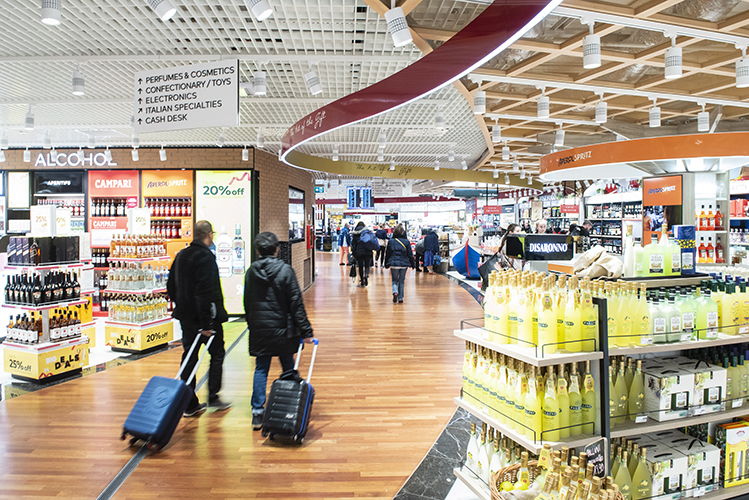
The vibrant new retail areas at Venice Marco Polo Airport include a 1,200sqm Aelia Duty Free walkthrough store. The long-term joint venture with Lagardère Travel Retail has resulted in commercial spaces that fit well into the elegant architectural context of the terminal.
Venice Marco Polo Airport factbox
2018: 11.2 million passengers
2018 passenger traffic growth: 8%
January 2019 passenger traffic growth: 8.6%
Key airline customers: easyJet, Volotea, Alitalia, British Airways, Lufthansa
Number of routes: 100+
Top 5 destinations: Paris-CDG, London Gatwick, Rome-FCO, Barcelona, Madrid
Direct China route top of Venice wish-list
Venice Marco Polo Airport’s 8% growth to 11.2 million passengers last year was driven partly by increasing long-haul traffic. American Airlines inaugurated a daily seasonal service from Chicago to Venice, growing the North American network to seven direct destinations served by five carriers. Meanwhile, Asiana Airlines has upgraded Venice from a seasonal charter to a scheduled year-round destination, launching a three-times-weekly service from Seoul in May 2018. Venice is Italy’s third intercontinental gateway, after Rome and Milan, and the long-haul segment accounted for nearly one million passengers in 2018, with eight carriers serving 10 destinations.
On the short-haul side, Air Europa reinstated double-daily Venice-Madrid services, offering important onward connections to Latin America. easyJet increased its Venice base to seven aircraft. Meanwhile, Volotea expanded the network from its Venice base by adding Karpathos and Zaragoza, and British Airways introduced new summer services from Cardiff and Birmingham (a city which claims to have more canals than Venice!).
Other carriers, including Austrian, LOT and Ukraine International Airlines, also increased their capacity.
The outlook for 2019 is, therefore, very positive and Scarpa forecasts a further 7% growth to about 12 million passengers.
“Network analysis and aviation marketing are the pillars of our traffic development strategy for the airports belonging to Italy’s North-East Airport System. We approach the airlines highlighting the traffic opportunities we see for new frequencies, additional capacity, and new destinations, as well as offering tailor-made marketing packages for the launch and promotion of the routes, aimed at raising the carrier and destination awareness in their respective markets.”
The 6% average annual growth rate at Venice Marco Polo since 2010 – compared with 3% nationally – is testament to the success of SAVE’s proactive route development strategy.
A direct China route is currently top of the wish-list. “Over 150,000 passengers travel from Venice to China and Hong Kong each year, despite the absence of direct flights,” Scarpa explains. “With 65,000 to Shanghai, 30,000 to Hong Kong and 25,000 to Beijing, Venice ranks as one of the largest unserved European markets from China. All the traffic components would contribute to the success of the route: outgoing business traffic, incoming leisure, as well as ethnic and cargo traffic. We’re in advanced negotiations with a Chinese carrier and we hope to announce the opening of a non-stop service to China very soon.”
Meanwhile, in May 2018, SAVE Group introduced ‘Venice Connects’, which is designed to develop connectivity through Venice by capturing the fast-growing self-connecting community. Airline partners currently include easyJet and Volotea, while Air Transat, Ryanair, Eurowings, Flybe, Transavia and Norwegian are in the pipeline.
“We analysed the flows tracked by our security team at the transit gates, which gave us an interesting outlook on this window of opportunity,” says Scarpa. “Though volumes are still on a developing trend, connecting traffic via Venice increased by 47% in 2018 compared with the previous year.”
The roles of Treviso, Verona, Brescia…and Brussels South Charleroi
Alongside Venice, the smaller airports of Treviso, Verona and Brescia also make an important contribution to SAVE’s strategy and to regional connectivity.
“When, at the end of 2014, SAVE became part of Catullo, which manages the Verona and Brescia airports, it was aware of the challenges awaiting it regarding the relaunch of traffic and the reorganisation of the company’s balance sheet. 2015 was the year of transition, but already in 2016 our goals had been met, in particular with regard to Verona’s traffic. The four airports in the SAVE Group network each have their own specific roles and features, but above all work in close relation with the needs of the territory.”
SAVE Group’s diverse range of airports also includes a 27.65% share in Brussels South Charleroi Airport. When asked about potential new shareholdings or acquisitions, Scarpa emphasises that SAVE is, at the moment, focused on the airports already in its network, while “taking into consideration interesting opportunities that may arise”.
The €900 million 2021 Master Plan
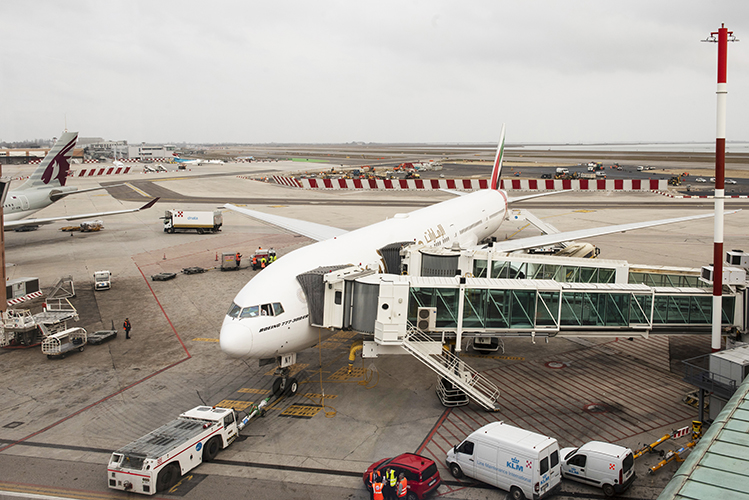
2019 represents an important year for Venice Marco Polo Airport, with work continuing on refurbishment of the runways, which will be complete in 2020.
The progressive increase in Venice Airport’s passenger numbers led to the development of the 2012-2021 Master Plan. This provides for a total investment of €900 million, and to date €475 million has been spent on works that have radically changed the face of the airport, including extension of the passenger terminal.
As we tour the terminal, what really stands out are the new retail areas, with a new 1,200sqm Aelia Duty Free store at its very heart. The long-term joint venture with Lagardère Travel Retail has resulted in commercial spaces that fit well into the elegant, airy design.
“The retail offer has been conceived with solutions specifically designed for our airport,” Scarpa comments. “The walkthrough duty free store, for example, offers numerous Italian luxury brands, together with products of Venetian and regional inspiration, especially in the area of food and wines.”
The Venetian ambience is further enhanced by the World of Venice high-end souvenir shop, and Torrefazione Cannaregio – a typical Venetian coffee shop.
SAVE energy: “Environment at the heart of our activity”
Numerous cities claim to be “the Venice of the…”, but Scarpa says the greatest similarities with other cities are on the issues of sustainability, the difficult balance between high visitor flows and respect for the environment, and the artistic heritage of a fragile city like Venice.
“I believe that much should and can still be done to govern these flows. Naturally, these are also fed from the airport, which is why attention to the environment is at the very centre of our activity, with programmes and investments that have accredited us at Level 3+ Neutrality of ACI’s Airport Carbon Accreditation.”
In the current Venice Airport Master Plan, €46.5 million is allocated to sustainability initiatives, in particular reducing carbon emissions.
“The most effective installation is the tri-generation plant,” Scarpa explains. “It was inaugurated in 2016 and allows the self-production of thermal, refrigerating and electrical energy, with a consequent reduction in the cost of energy requirements. In the last two years, SAVE has substituted about 30 diesel-powered vehicles with as many electric or hybrid vehicles. To all this, we add the constant monitoring of environmental sources such as noise, water, and air, with corrective actions when necessary. The energy we buy from our suppliers also comes from renewable sources, such as hydroelectric.”
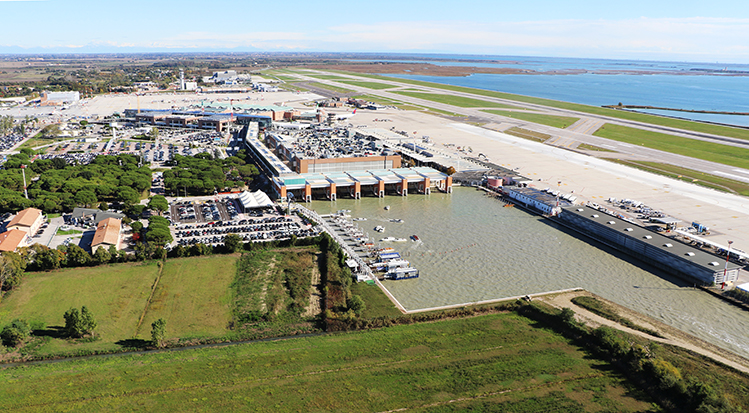
Attention to the environment is at the very centre of Venice Marco Polo Airport’s activity. The airport is accredited at Level 3+ Neutrality of ACI’s Airport Carbon Accreditation, and in the current Venice Airport Master Plan, €46.5 million is allocated to sustainability initiatives, in particular reducing carbon emissions.
Progressive implementation of digital technologies
In its recent annual report on airports, eDreams – one of Europe’s largest online travel companies – compiled a list of the ‘Best Airports in the World’ based on a survey of 80,000 travellers. Venice came above all other Italian airports, and Scarpa highlights the progressive implementation of digital technologies as a key factor.
Unlimited free WiFi is a big feature of the Venice digital strategy, and in just a few weeks the new airport app will debut which, in dialogue with the website, will contain a section linked to the new loyalty card.
“All the websites of the SAVE Group airports have been recently renovated,” Scarpa adds. “The restyling is a necessary evolution, as 70% of people accessing the websites now do so through smartphones and tablets, hence the creation of a more modern and more easily accessible interface.”
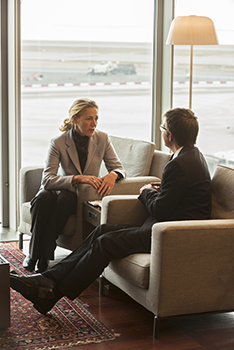
Monica Scarpa, CEO SAVE Group, explains to Airport Business’ Ross Falconer that “network analysis and aviation marketing are the pillars of our traffic development strategy for the airports belonging to Italy’s North-East Airport System”.
In line with increasing Chinese traveller numbers, and the desire to secure a direct China route, some sections of the Venice Airport website are now translated into Chinese. Indeed, the website was certified at the “Welcome Chinese” standard by the China Tourism Authority in 2017.
Venice Marco Polo Airport is also active on the main social media networks, with 65,000 ‘likes’ on Facebook, 8,000+ followers on Twitter, and almost 8,000 followers on Instagram.
“Meanwhile, we are working on beacon technology, we are carrying out a CRM project, and we are evaluating the implementation of a chatbot system.”
A similarly progressive approach is being applied to passenger processes, with self-service technologies prevalent throughout the airport journey. Passengers can use the 24 self-check-in kiosks, automated bag drop, and e-passport gates, while a monitoring system allows the airport to manage passenger flows in the security area in real-time.
As our discussion draws to a close, it is clear that the traveller remains at the very heart of SAVE Group’s current and future investment plans.
“2019 represents an important year, with work continuing on refurbishment of the Venice Airport runways, which will be complete in 2020. We are also finishing the new extension of the passenger terminal in the extra-Schengen area. Looking ahead, we are developing a new Master Plan for 2022-2035. For us, the driving force in all of these developments is the customer experience.”







